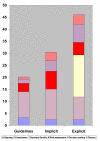Medical communication and technology: a video-based process study of the use of decision aids in primary care consultations
- PMID: 17214891
- PMCID: PMC1781432
- DOI: 10.1186/1472-6947-7-2
Medical communication and technology: a video-based process study of the use of decision aids in primary care consultations
Abstract
Background: Much of the research on decision-making in health care has focused on consultation outcomes. Less is known about the process by which clinicians and patients come to a treatment decision. This study aimed to quantitatively describe the behaviour shown by doctors and patients during primary care consultations when three types of decision aids were used to promote treatment decision-making in a randomised controlled trial.
Methods: A video-based study set in an efficacy trial which compared the use of paper-based guidelines (control) with two forms of computer-based decision aids (implicit and explicit versions of DARTS II). Treatment decision concerned warfarin anti-coagulation to reduce the risk of stroke in older patients with atrial fibrillation. Twenty nine consultations were video-recorded. A ten-minute 'slice' of the consultation was sampled for detailed content analysis using existing interaction analysis protocols for verbal behaviour and ethological techniques for non-verbal behaviour.
Results: Median consultation times (quartiles) differed significantly depending on the technology used. Paper-based guidelines took 21 (19-26) minutes to work through compared to 31 (16-41) minutes for the implicit tool; and 44 (39-55) minutes for the explicit tool. In the ten minutes immediately preceding the decision point, GPs dominated the conversation, accounting for 64% (58-66%) of all utterances and this trend was similar across all three arms of the trial. Information-giving was the most frequent activity for both GPs and patients, although GPs did this at twice the rate compared to patients and at higher rates in consultations involving computerised decision aids. GPs' language was highly technically focused and just 7% of their conversation was socio-emotional in content; this was half the socio-emotional content shown by patients (15%). However, frequent head nodding and a close mirroring in the direction of eye-gaze suggested that both parties were active participants in the conversation
Conclusion: Irrespective of the arm of the trial, both patients' and GPs' behaviour showed that they were reciprocally engaged in these consultations. However, even in consultations aimed at promoting shared decision-making, GPs' were verbally dominant, and they worked primarily as information providers for patients. In addition, computer-based decision aids significantly prolonged the consultations, particularly the later phases. These data suggest that decision aids may not lead to more 'sharing' in treatment decision-making and that, in their current form, they may take too long to negotiate for use in routine primary care.
Figures
References
-
- Edwards A, Elwyn G. Evidence-based Patient Choice Inevitable or Impossible? Oxford , Oxford University Press; 2001.
-
- Whitney S, McGuire A, McCullough L. A typology of shared decision-making, informed consent, and simple consent. Annals of Internal Medicine. 2003;140:54–59. - PubMed
-
- May C, Mead N. Patient-centredness: A history. In: Dowrick C, Frith L, editor. Ethical Issues in General Practice: Uncertainty and Responsibility. London , Routledge; 1999. pp. 76–91.
Publication types
MeSH terms
Grants and funding
LinkOut - more resources
Full Text Sources
Medical


